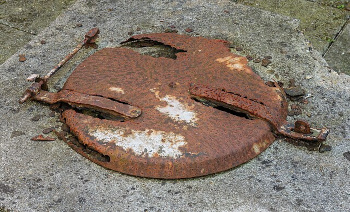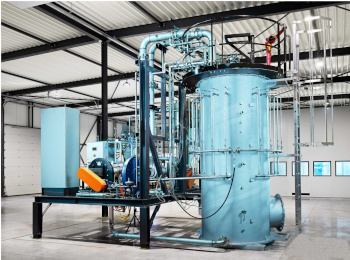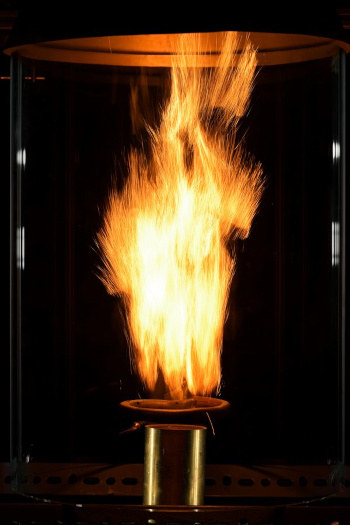Iron as a Fuel
September 18, 2023
Iron and
steel are the least
expensive of the
metals, and they comprise about 95% of all the metal
tonnage produced annually in the
world.[1] The August, 2023,
price of
iron ore is about $105/
metric ton, as compared with the price of
gold at about $1,950/
Troy ounce, a
ratio of gold price to iron price of 32,150.[1] The table shows the metric tons of
pig iron and raw steel production in the
United States for the years 2018-2022.[1]
US Iron and Steel Production, 2018-2022
| Year |
Pig Iron
Million Metric Tons |
Raw Steel
Million Metric Tons |
| 2018 |
24.1 |
86.6 |
| 2019 |
22.3 |
87.8 |
| 2020 |
18.3 |
72.7 |
| 2021 |
22.2 |
85.8 |
| 2022 |
21.0 |
82.0 |

Iron is inexpensive; but, as the
saying goes, "
You get what you pay for." The problem with iron and inexpensive
alloys of iron, including steel, is their
rusting. Rust is the
oxidation of iron to produce
iron oxide, generally
hydrous iron(III) oxides (Fe2O3·nH2O).
(Rusted lid of a rain cistern, a Wikimedia Commons image by Agnes Monkelbaan.)
The
ancient Greeks understood the advantage of using iron as a
structural material, provided that its
corrosion could be overcome. In the
construction of the
Parthenon, they
secured its
marble blocks with iron
H pins in prepared
grooves, but they
covered the iron with
molten lead.[2] The lead protected the iron from
environmental water, and the
soft lead served also to
cushion the
joints from
seismic tremors.[2]
However, an 1898
restoration of the Parthenon by
Greek architect,
Nikolaos Balanos (1869-1943), used iron pins without a protective coating.[2] Water eventually rusted the iron, which caused its
expansion,
cracking the marble.[2] Another restoration attempt, started in 1975, is designed to correct these problems and restore nearby buildings in the
Athenian Acropolis.
Iron releases a lot of
energy when
forming its
oxide, as the following
graph shows.

Gibbs free energy of formation of haematite (often called hematite) from the elements as a function of temperature. These data are from the JANAF Thermochemical Tables, available at the NIST Standard Reference Data Website.[3] I prefer kilocalories to joules because of my materials science background, so I converted the tabulated SI units of free energy to kilocalories. Negative energy indicates an exothermic reaction. The graph was produced using Gnumeric. Click for larger image.
As I wrote in an earlier article (
Metal Powder Energy, January 18, 2021), a
research team from the
Eindhoven University of Technology used
combustion of iron as a
renewable energy source in a
pilot operation for
beer brewing at a
Noord-Brabant brewery.[4-6] Since iron
powder combusts without a release of
carbon dioxide, its use does not contribute to
global warming. The iron powder is used as a
circular fuel in which the oxidized iron can be
recycled into iron using
renewable energy sources.
One other advantage of iron fuel is its
safety. There is no energy lost during storage, and it can be easily
transported. One disadvantage, however, is its low
specific energy, just 1.4
kWh/
kg, so its
energy density is about an
order of magnitude less than
gasoline.[4] This means it isn't suitable as an
automotive fuel; but, fixed applications, such as
industrial heating and
residential heating, and as an energy storage material for
electrical system energy storage, are possible.
The
circular fuel process involves the
conversion of the iron oxide caused by the iron combustion back to
elemental iron by
reaction with
hydrogen. This converts the contained
oxygen of the oxide to
water, and it can be done in several ways. One of these is just heating the iron oxide in
hydrogen at 800-1000
°C.[4] There's a more rapid method of
blowing the iron powder in a
stream of hydrogen at 1100-1400°C, or the use a
fluidized bed reactor at the lower temperature of about 600°C for a longer time.[4]
Today, two and a half years later, the
Dutch brewery's 100
kilowatt pilot plant has now expanded into a one
megawatt iron combustion heat generator named IRON+, created in part by
Metalot, a
startup company spun out of the Eindhoven University of Technology.[7] Another spin-off from Eindhoven, RIFT, for
Renewable Iron Fuel Technology, used iron fuel to heat five
homes.[7]
McGill University pioneered iron fuel
technology,[8] and a McGill University startup company, Altiro Energy, created a 10 kilowatt unit that they intend to scale up.[7] Surprisingly, the initial McGill University research was funded by the
European Space Agency and the
Canadian Space Agency.[7]

An iron fuel demonstration plant running in Budel, near Eindhoven, The Netherlands. This plant can produce one megawatts of steam in a unit that's sited in a warehouse. A plant such as this can be easily scaled to produce much more power.
(European Space Agency image.)
Metalot and the
Technical University of Darmstadt (Darmstadt, Germany) have determined that it’s more
efficient to produce iron from hydrogen
gas than to produce the hydrogen fuel alternative,
liquid hydrogen.[7] As work progresses, some technical problems have been
mitigated. One problem is that iron does not
ignite as easily as
hydrocarbon fuels, and its combustion rate is slower, making for unstable burning and easy extinguishing.[7] It was found that the addition of some
natural gas assists with initial ignition.[7] Other techniques stabilize the combustion to prevent its extinguishing.[7]

Iron burning has been tested in microgravity aboard European Space Agency sounding rockets by a research team from McGill University and Eindhoven University of Technology.
(European Space Agency image.)
Just as hydrocarbon combustion leads to unwanted
carbon soot, iron combustion produces iron oxide
nanoparticles that can't be converted into iron. At present, the iron loss is less than 0.3 percent, and these nanoparticles are captured in a
HEPA filter.[7] Also, not all of the iron is burned into iron oxide.[7] After some
process optimization, it would be possible to use
renewable energy to produce iron, store it as long as necessary, and also
transport it where power when needed.[7]
Jeffrey M. Bergthorson, one of the researchers and an associate professor at McGill University, is
quoted in
IEEE Spectrum as saying,
"Places that have excess energy could make iron, and others can buy it. This way, you could commodify renewable energy so it can be globally distributed without the need for transmission lines. Metals can solve a big problem in the renewable energy transition: long-duration energy storage."[7]
References:
- Iron and Steel Statistics and Information, National Minerals Information Center, U.S. Geological Survey, U.S. Department of the Interior.
- Evan Hadingham, "Unlocking Mysteries of the Parthenon," Smithsonian Magazine, February, 2008.
- Fe2O23 (Haematite) from the NIST-JANAF Thermochemical Tables, Fourth Edition, Part I and Part II, M.W. Chase, Jr., Editor, found at NIST Standard Reference Data, Hematite (Fe2O3). Earlier data can be found in C. E. Wicks and F. E. Block, "Thermodynamic Properties of 65 Elements - Their Oxides, Halides, Carbides, and Nitrides," U. S. Bureau of Mines Bulletin 605, U. S. Government Printing Office (1963);, with an Online version, via The University of North Texas Library.
- Evan Ackerman, "Iron Powder Passes First Industrial Test as Renewable, Carbon Dioxide-Free Fuel," IEEE Spectrum, November 13, 2020.
- World's first iron-based energy storage system, YouTube Video by Solid, September 6, 2018,
- Iron Powder - the green energy solution, YouTube Video by the Eindhoven University of Technology, October 21, 2020.
- Prachi Patel, "Iron Fuel Shows Its Mettle," IEEE Spectrum, June 22, 2023.
- J.M.Bergthorson, S.Goroshin, M.J.Soo, P.Julien, J.Palecka, D.L.Frost, and D.J.Jarvis, "Direct combustion of recyclable metal fuels for zero-carbon heat and power," Applied Energy, Vol. 160 (December, 2015), pp. 368-382, https://doi.org/10.1016/j.apenergy.2015.09.037.
Linked Keywords: Iron; steel; cost; expensive; metal; ton; tonnage; production (economics); produced; year; annually; world; price; iron ore; metric ton; gold; Troy ounce; ratio; pig iron; United States; saying; common law of business balance; You get what you pay for; alloy; rust; rusting; oxide; oxidation; iron oxide; hydrous iron(III) oxides (Fe2O3·nH2O); lid; rain; cistern; Wikimedia Commons; Agnes Monkelbaan; Ancient Greece; ancient Greeks; structural material; corrosion; construction; Parthenon; secure; secured; marble; pin; grooves; coating; covered; melting; molten; lead; environmental; water; ductility; soft; cushion; kinematic pair; joint; seismic wave; seismic tremor; conservation-restoration of cultural heritage; restoration; Greece; Greek; architect; Nikolaos Balanos (1869-1943); expansion (geometry); fracture; cracking; Acropolis of Athens; Athenian Acropolis; Gibbs free energy; energy; chemical reaction; oxide; Cartesian coordinate system; graph; Free energy of formation of haenmatite from the elements as a function of temperature; formation; hematite; haematite; chemical element; element; function (mathematics); temperature; data; JANAF Thermochemical Tables; NIST Standard Reference Data Website; kilocalorie; joule; materials science; International System of Units; SI units; negative number; exothermic reaction; Gnumeric; research; Eindhoven University of Technology; combustion; renewable energy; renewable energy source; pilot plant; pilot operation; beer; brewing; Noord-Brabant; powder (substance); carbon dioxide; global warming; thermodynamic cycle; circular; fuel; recycle; renewable energy sources; safety; transport; transported; specific energy; kilowatt-hour; kWh; kilogram; kg; energy density; order of magnitude; gasoline; motor fuel; automotive fuel; industry; industrial; heat; heating; residence; residential; central heating; electric power transmission; electrical system; energy storage; chemical reaction; conversion; chemical element; elemental; reaction; hydrogen; oxygen; water; Celsius; °C; blow; blowing; fluid dynamics; stream; fluidized bed reactor; Netherlands; Dutch; kilowatt; pilot plant; megawatt; Metalot; startup company; research spin-off; spun out; home; McGill University; innovator; pioneered; technology; European Space Agency; Canadian Space Agency; demonstration plant; Budel; Eindhoven, The Netherlands; steam; warehouse; power (physics); Technical University of Darmstadt (Darmstadt, Germany); efficient energy use; gas; liquid hydrogen; mitigation; mitigated; ignite; hydrocarbon; natural gas; pilot experiment; test; microgravity; sounding rocket; carbon; soot; nanoparticle; HEPA filter; process optimization; renewable energy; transport; Jeffrey M. Bergthorson; quotation; quoted; IEEE Spectrum; commodity; commodify; global; distribution; distributed; overhead power line; transmission lines.